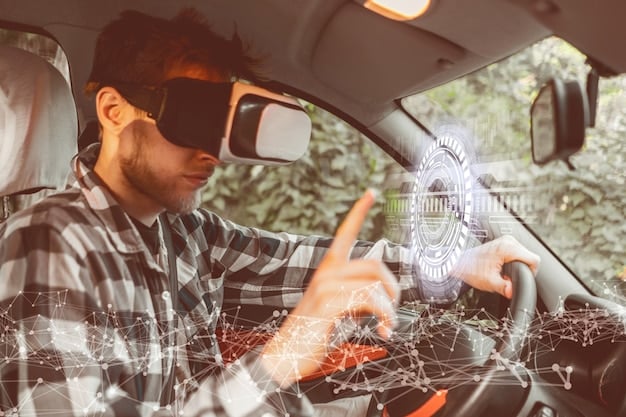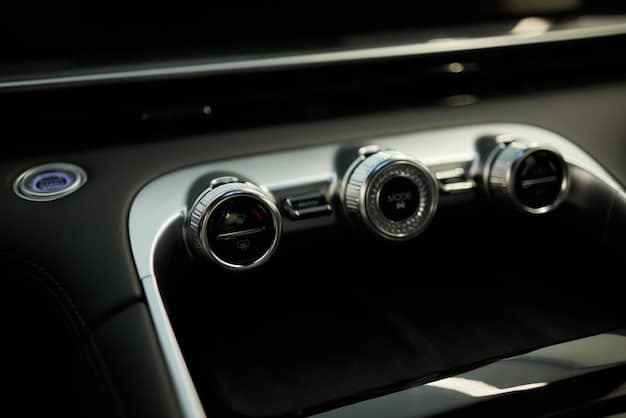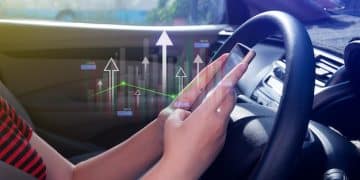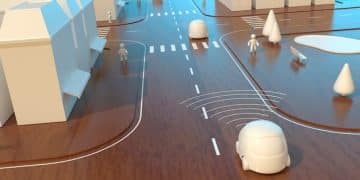How ADAS Prevents Collisions: Evolution & Future Trends

Advanced Driver-Assistance Systems (ADAS) are rapidly evolving with technologies like enhanced sensor fusion, AI-driven decision-making, and vehicle-to-everything (V2X) communication to significantly reduce and prevent collisions, paving the way for safer and more autonomous driving experiences.
The automotive industry is undergoing a technological revolution, with Advanced Driver-Assistance Systems (ADAS) at the forefront. These systems are not just about adding convenience; they’re fundamentally changing how vehicles operate, aiming to drastically reduce collisions and enhance road safety.
Understanding the Core of Advanced Driver-Assistance Systems (ADAS)
Advanced Driver-Assistance Systems (ADAS) represent a suite of technologies designed to assist drivers in various driving tasks, enhancing safety and convenience. These systems use a combination of sensors, software, and processing power to perceive the vehicle’s surroundings and provide alerts, warnings, or even intervene to prevent accidents.
Key Components of ADAS
ADAS technology relies on several key components working in harmony to provide a comprehensive safety net.
- Sensors: These include cameras, radar, lidar, and ultrasonic sensors, which gather data about the vehicle’s surroundings.
- Processing Units: High-performance computers analyze the sensor data to detect potential hazards and make decisions.
- Software Algorithms: Sophisticated algorithms interpret the sensor data and trigger appropriate responses, such as warnings or automatic braking.
- Actuators: These are the mechanical components that carry out the system’s commands, such as applying the brakes or adjusting the steering.
The integration of these components allows ADAS to perform a wide range of functions, from basic alerts to automated interventions, ultimately contributing to safer driving.

Current ADAS Features and Their Impact on Collision Prevention
Today’s vehicles are equipped with a variety of ADAS features, each designed to address specific types of collisions and driving scenarios. These features have already demonstrated a significant impact on reducing accidents and improving road safety.
Lane Departure Warning and Lane Keeping Assist
These systems use cameras to monitor the vehicle’s position within its lane. Lane Departure Warning alerts the driver when the vehicle begins to drift out of its lane, while Lane Keeping Assist can automatically steer the vehicle back into the lane.
Adaptive Cruise Control
Adaptive Cruise Control (ACC) maintains a set speed and automatically adjusts it to maintain a safe following distance from the vehicle ahead. ACC can also bring the vehicle to a complete stop if necessary.
Automatic Emergency Braking
Automatic Emergency Braking (AEB) systems use sensors to detect potential collisions with vehicles, pedestrians, or other obstacles. If the driver does not react in time, the system can automatically apply the brakes to avoid or mitigate the impact.
These features, among others, are significantly contributing to reducing the frequency and severity of collisions on roadways, making driving safer for everyone.
Advancements in Sensor Technology: The Eyes and Ears of Future ADAS
The effectiveness of ADAS heavily relies on the quality and capabilities of its sensors. Recent advancements in sensor technology are enabling ADAS to perceive the environment with greater accuracy and reliability.
Radar Technology
Radar (Radio Detection and Ranging) has been a staple in ADAS for years, providing reliable detection of objects in a wide range of weather conditions. Modern radar systems offer increased range, resolution, and the ability to distinguish between different types of objects.
Lidar Technology
Lidar (Light Detection and Ranging) uses laser beams to create a detailed 3D map of the vehicle’s surroundings. Lidar offers superior accuracy and resolution compared to radar, especially in complex environments.
Camera-Based Systems
Cameras are essential for ADAS, providing visual information about lane markings, traffic signs, and other objects. Advancements in camera technology include higher resolution, wider dynamic range, and improved low-light performance.
These sensor advancements are crucial for enabling more sophisticated ADAS functions and improving overall safety.

The Role of AI and Machine Learning in Enhancing ADAS Performance
Artificial intelligence (AI) and machine learning (ML) are playing an increasingly important role in enhancing the performance of ADAS. AI algorithms can analyze vast amounts of sensor data to identify patterns, predict potential hazards, and make more informed decisions.
Object Recognition and Classification
AI-powered object recognition systems can accurately identify and classify different types of objects, such as vehicles, pedestrians, cyclists, and animals. This allows ADAS to respond appropriately to each situation.
Predictive Modeling
ML algorithms can learn from historical data to predict the behavior of other road users. This enables ADAS to anticipate potential hazards and take proactive measures to avoid collisions.
Sensor Fusion
AI can effectively combine data from multiple sensors to create a more complete and accurate understanding of the vehicle’s surroundings. This improves the reliability and robustness of ADAS in challenging driving conditions.
The integration of AI and ML is enabling ADAS to become more intelligent, proactive, and effective at preventing collisions.
Vehicle-to-Everything (V2X) Communication: A New Frontier in Collision Avoidance
Vehicle-to-Everything (V2X) communication is an emerging technology that enables vehicles to communicate with each other, as well as with infrastructure such as traffic lights and road signs. This technology has the potential to revolutionize collision avoidance by providing drivers with real-time information about potential hazards.
Vehicle-to-Vehicle (V2V) Communication
V2V communication allows vehicles to share information about their speed, position, and direction. This enables ADAS to detect potential collisions even when the other vehicle is not visible.
Vehicle-to-Infrastructure (V2I) Communication
V2I communication allows vehicles to receive information from infrastructure such as traffic lights, road signs, and emergency vehicles. This can provide drivers with early warnings about upcoming hazards.
Benefits of V2X
- Enhanced Situational Awareness
- Reduced Collision Risk
- Improved Traffic Flow
- Increased Safety for Vulnerable Road Users
V2X communication is a promising technology that has the potential to significantly enhance the effectiveness of ADAS and reduce collisions.
Challenges and Future Directions in ADAS Development
While ADAS technology has made significant strides in recent years, there are still challenges to overcome. Addressing these challenges will pave the way for more advanced and reliable collision prevention systems.
Sensor Limitations
Current sensors have limitations in certain weather conditions, such as heavy rain, snow, and fog. Improving the robustness and reliability of sensors in all weather conditions is a key area of focus.
Data Privacy and Security
ADAS systems collect vast amounts of data about driving behavior. Ensuring the privacy and security of this data is essential to maintain public trust.
Ethical Considerations
As ADAS systems become more autonomous, ethical considerations must be addressed. For example, how should the system prioritize safety in unavoidable collision scenarios?
Future Directions
- Enhanced Sensor Fusion
- Improved AI Algorithms
- Greater V2X Integration
Overcoming these challenges and pursuing these future directions will lead to even more effective and reliable ADAS systems that significantly reduce collisions and improve road safety.
| Key Aspect | Brief Description |
|---|---|
| 🚗 ADAS Core | Systems designed to assist drivers and enhance vehicle safety using sensors and AI. |
| 🚨 Collision Prevention | ADAS features like AEB and lane keeping assist reduce collision risks. |
| 📡 Sensor Advancements | Evolving radar, lidar, and camera tech enhance ADAS awareness. |
| 🌐 V2X Communication | Vehicles share data to improve safety by communicating with each other and infrastructure. |
Frequently Asked Questions
▼
The primary goal of ADAS is to enhance vehicle safety by assisting drivers in preventing collisions and mitigating the severity of unavoidable accidents.
▼
AEB uses sensors to detect potential collisions, delivering alerts and automatically applying brakes if a driver fails to respond promptly to an impending crash.
▼
Current ADAS sensors often struggle in adverse weather conditions like heavy rain, snow, and fog, which can reduce their accuracy and effectiveness.
▼
AI improves ADAS by enabling better object recognition, predictive modeling, and sensor fusion, enhancing the system’s decision-making process and overall reliability.
▼
V2X allows vehicles to communicate with each other and infrastructure, sharing critical data to improve situational awareness and prevent collisions in real-time.
Conclusion
As Advanced Driver-Assistance Systems (ADAS) continue to evolve, their potential to transform road safety is immense. Through advancements in sensor technology, artificial intelligence, and vehicle communication, ADAS is paving the way for a future where collisions are significantly reduced, and driving experiences are safer and more efficient.





